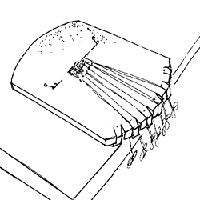
This picture shows all four sizes of C-Lon Bead Cord and the sizes of Miyuki beads that can be strung onto the cord using a beeswax self needle. See one of my earlier blog about the best way of loading beads onto cord. From left to right:
- C-Lon Tex 400 Bead Cord with Miyuki E's (twice/2x), 6/0s, and 8/0s
- C-Lon Bead Cord with Miyuki 6/0s (2x), 8/0s, and 11/0s
- C-Lon Fine Weight Cord with Miyuki 8/0s (2x), 11/0s, and 15/0s
- C-Lon Micro Cord with Miyuki 8/0s (2x), 11/0s, and 15/0s
C-Lon Bead Cord and to a certain extend C-Lon Tex 400 Bead Cord, the 'heavyweight bead cord', tend to curl. This can be especially annoying when working with micro macrame, as it makes the process of finding the right cord to work with more daunting especially when working with a multitude of cords. For applications such a crochet, knitting or kumihimo with EZ-Bobs, the cord having a memory of being on the spool all curled up does not matter. For anyone wanting the curls to go away, several solutions come to mind.
No More Curls Methods
- When unwinding the thread, give it a pull one arm's length at a time.
- Cut the cord the day before and add a weight to the ends overnight.
- Steam the cord.
- Iron the cord with a warm iron - a hot iron will damage the cord.
Alternative Method
Here is a another good method for micro macrame and Cavandoli knotting, when you need multiple cords, all of the same length. I use this method for workshops or when I plan my work a day ahead of time.
- Set up 2 winding posts, warping posts or cup hooks set into pieces of wood attached by a C-clamp to fixed positions at the distance desired for your cord ends.
- Attach the cord to the post/hook on your left (post/hook #1).
- Unwind the cord towards the second post/hook and give it a hard pull.
- Wind it around the second post/hook on your right (post/hook #2).
- Return to post/hook #1, unwinding, giving a hard pull and wind the cord around #1.
- Repeat steps 3-5 however many times until you have the desired number of cords.
- Tie the end back at post/hook #1.
- Optional - Let the cord sit on the posts/hooks overnight.
- Cut the cords at post/hook #1. Hold the cords by their fold at post/hook #2.
Best with your creative projects! - Marion
To purchase C-Lon Bead Cord > Marion Jewels in Fiber Store
Note on Ironing C-Lon Bead Cord
Use a warm setting. The lowest setting on my iron is acetate/nylon. I tested it with 6 - 48 inches long cords folded in half (24 inches long from fold/loop to ends). For speed I raise the setting to polyester, but then you need to iron quickly. Do not leave the iron in one spot with higher heat setting. Nylon will melt!
















